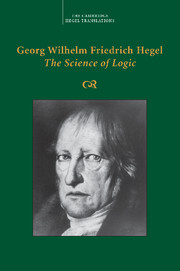Section III - Actuality
Published online by Cambridge University Press: 30 September 2021
Summary
Actuality is the unity of essence and concrete existence; in it, shapeless essence and unstable appearance – or subsistence without determination and manifoldness without permanence – have their truth. Although concrete existence is the immediacy that has proceeded from ground, it still does not have form explicitly posited in it; inasmuch as it determines and informs itself, it is appearance; and in developing this subsistence that otherwise only is a reflection-into-other into an immanent reflection, it becomes two worlds, two totalities of content, one determined as reflected into itself and the other as reflected into other. But the essential relation exposes the formality of their connection, and the consummation of the latter is the relation of the inner and the outer in which the content of both is equally only one identical substrate and only one identity of form. – Because this identity has come about also in regard to form, the form determination of their difference is sublated, and that they are one absolute totality is posited.
This unity of the inner and outer is absolute actuality. But this actuality is, first, the absolute as such – in so far as it is posited as a unity in which the form has sublated itself, making itself into the empty or external distinction of an outer and inner. Reflection relates to this absolute as external to it; it only contemplates it rather than being its own movement. But it is essentially this movement and is, therefore, as the absolute's negative turning back into itself.
Second, it is actuality proper. Actuality, possibility, and necessity constitute the formal moments of the absolute, or its reflection.
Third, the unity of the absolute and its reflection is the absolute relation, or rather the absolute as relation to itself, substance.
- Type
- Chapter
- Information
- Publisher: Cambridge University PressPrint publication year: 2010

